Things to do in Cusco if you have a Cusco Airport Layover or Extended Cusco Airport Stopover
Take time out to acclimatize
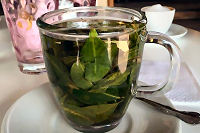 Relax in Cusco before moving on. At 11,000 feet (3,400 metres) above sea level, altitude sickness (soroche) can be a problem. Altitude sickness tends to sneak up on you and although its symptoms may not be apparent at first, it has the potential to develop into something extremely dangerous. Be sure to accilimatize before heading out to any sites.
Relax in Cusco before moving on. At 11,000 feet (3,400 metres) above sea level, altitude sickness (soroche) can be a problem. Altitude sickness tends to sneak up on you and although its symptoms may not be apparent at first, it has the potential to develop into something extremely dangerous. Be sure to accilimatize before heading out to any sites.
You won't be bored. Cuzco is a beautiful city with well preserved colonial architecture, evidence of a rich and complex history. The city itself represents the centre of indigenous Quechua culture in the Andes. By merely walking the streets, you will see the layers of history: Spanish colonial buildings erected directly atop Inca walls line the square. The modern tourist nightlife flourishes in their midst.
Tip: Remember on the first day to take it slow and stay away from the bars the first night. Most hotels offer coca tea (coca leaves are the traditional native remedy for altitude sickness) and finding products made out of coca like coca candy is easy to find in Cusco. If you expect to get drug tested upon your return home, however, avoid all products with coca, drink plenty of water and look into Diamox/Acetazolamide (available at a pharmacy) to help deal with the adjustment period.
Get a Boleto to see the ruins and sights around Cusco
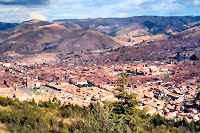 A boleto turistico is required for access to some of the sights in and around Cuzco. You can buy one at the Oficina Ejecutiva del Comité (OFEC), at Av Sol 103.
A boleto turistico is required for access to some of the sights in and around Cuzco. You can buy one at the Oficina Ejecutiva del Comité (OFEC), at Av Sol 103.
The Boleto ticket gives access to the following sites in Cuzco: Santa Cataline Monastery, Museo Municipal de Arte Contemporáneo, Museo Historico Regional, Museo del Sitio del Qoricancha, Museo de Arte Popular, Centro Qosqo de Arte Nativo Danzas Folklórico, and Monumento Pachacuteq. And around Cuzco: Sacsayhuamán, Qénqo, Pukapukara, Tambomachay, Chinchero and the ruins of Pisac, Ollantaytambo, Tipón and Pikillacta.
There are three different kind of Boleto tickets:
- A full ticket (valid for 10 days and for all sites), PEN 130
- A student ticket (ISIC student card required as proof), PEN 70
- A partial ticket (valid for 1 day only, and a limited number of sites)
The Four Archaeological Ruins: Sacsayhuaman, Qenko, Pukapukara, Tambomachay
 There are 4 major archaelogical ruins around Cusco:
There are 4 major archaelogical ruins around Cusco:
- Sacsayhuaman is the 1st (closest) and largest of the ruins outside Cuscos. Sacsayhuaman is the site of the 1536 battle in which dozens of Pizarro's men charged uphill to battle the forces of the Inca. The amazing Inca Sacsayhuamán (sometimes called Saqsaywaman and pronounced "Sock-say-wah-mun") ruins sit high above Cuzco. It is a steep climb from the Plaza de Armas up Plateros street which changes to Saphi. Look for the long staircase on the right, follow the paved curvy road up to the next cobblestone pedestrian path and follow this climb past the first closed control point to the second control. No need to take a cab if you can handle it. But, be careful, as robberies have been reported in mornings and evenings. Read up on the battle beforehand as the guides don't discuss it. A view of the circular base of the former tower as shown in many of the photos is not possible due to the protective ropes. Go earlier in the morning as later visits are disrupted by whistles from guards telling unobservant tourists to get off the ruins. Accessible with the Boleto turistico.
- Qenko,(or Q'enqo) is the 2nd site up the road from Sacsayhuamán. Take the cumbi shared busses up the hill for PEN 1 or take a walk of about 0.5–1 km up a gradual incline to visit the site. Its name means "Zig-Zag" in Quecha, and probably refers to the Zig-Zag channels carved into a rock. Explore the pass through cave and view the altar on which llamas were sacrificed. The large erect stone shown on the boleto turistico is a solar calendar. On each side of the stone is a square wall two stones high. Each stone is representative of a number of days, the total is the total days in the year. Opposite the stone are the familiar windows in which mummies and human remains were discovered. Accessible with the Boleto turistico.
- Pukapukara (red fort) is named after the red hue of the hillsides nearby, and is the 3rd site along the route. Even hearty walkers will find the walk a bit long and a steep, despite the paved and well traveled road, however the views along the walk are great. Small mud brick bars are intermittent between the sites. Hire a taxi or take a cumbi shared bus up from Qenko for PEN 1 to save time and energy. A larger site than Q'enqo, the guides have more to say about this site. It was likely a checkpoint or military control. Offerings of coca leaves among other things were received here. Accessible with the Boleto turistico.
- Tambomachay is the 4th and most distant ruin on the route from Cuzco. It is a small site with an ornamental fountain whose source is unknown (reportedly archaeologists lack the tools necessary to determine the source without damaging the site). Speculation is that it is an underground spring; in several Incan sites (such as Ollentaytambo) water sources were covered or underground to protect the water supply from poisoning. Take a cumbi all the way back to Plaza de las Armas in Cuzco for PEN 1. Accessible with the Boleto turistico (includes bathroom access).
- To see all 4 sites in 1 day: Pre-arrange your tour, or negotiate for a guide at the Sacsayhuamán ticket control (ask the guard which guides have been through the government training). Allow 4-5 hours for the trip. Pack a snack (water is available along the way). Bathrooms (clean and well maintained) are only available at the final site Tambomachay. If you don't want to hire a guide, take a taxi or combi to Tambomachay/Pukapukara to start, then walk back down the hill.
Qoricancha, the Inca Sun Temple
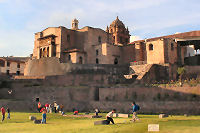 Qoricancha, the Sun Temple, was the central site of worship for the Incas. Like so many other testimonies of fantastic Inca architecture, it was severely devastated by the conquistadores, the Spanish conquerors, who built their Christian church, Santo Domingo, on top of the ruins. Yet most of the bottom part of the temple is fairly well preserved and makes the site worth several hours of your time. The site is one of the best in Cuzco, or Qosqo in the Quechua language, containing both Catholic and Inca heritage with stunning views of the surrounding area. Looking at the outside from Avenida del Sol, you get a perfect view of the church standing on the temple and you see the differences of the Inca and the Spanish way of building. Accessible with the Bolito turistico.
Qoricancha, the Sun Temple, was the central site of worship for the Incas. Like so many other testimonies of fantastic Inca architecture, it was severely devastated by the conquistadores, the Spanish conquerors, who built their Christian church, Santo Domingo, on top of the ruins. Yet most of the bottom part of the temple is fairly well preserved and makes the site worth several hours of your time. The site is one of the best in Cuzco, or Qosqo in the Quechua language, containing both Catholic and Inca heritage with stunning views of the surrounding area. Looking at the outside from Avenida del Sol, you get a perfect view of the church standing on the temple and you see the differences of the Inca and the Spanish way of building. Accessible with the Bolito turistico.
- Qoricancha also is the starting point of the yearly processions at Inti Raymi, the Sun Festival, in the remembrance of the Inca tradition of celebrating the winter solstice. This procession then moves all the way up to Saxayhuamán.
- In order to understand, especially the remarkable remains in the Inca section, a guided tour is advisable.
Sacred, Magical and Medicinal Plants Museum
 Sacred, Magical and Medicinal Plants Museum (Calle Santa Teresa 351) is a privately owned museum, established in 2011 as a non-profit organization. The mission of the Museum is to contribute to the conservation of the vegetal wealth of the Amazon and the Andes of South America, in particular those plants that contribute to human well-being, and the associated indigenous traditional knowledge on the medicinal, ritual and shamanic use of plant resources. Admission. Closed Sundays.
Sacred, Magical and Medicinal Plants Museum (Calle Santa Teresa 351) is a privately owned museum, established in 2011 as a non-profit organization. The mission of the Museum is to contribute to the conservation of the vegetal wealth of the Amazon and the Andes of South America, in particular those plants that contribute to human well-being, and the associated indigenous traditional knowledge on the medicinal, ritual and shamanic use of plant resources. Admission. Closed Sundays.
Museo del Centro de Textiles Tradicionales de Cusco
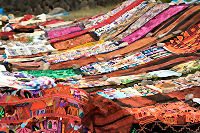 Museo del Centro de Textiles Tradicionales de Cusco (Av Sol. No. 603) is located inside El Centro's textile store. The beautiful museum features a gallery containing displays of traditional Quechuan and Andean textiles. The museum explains the historical significance of textiles and the techniques by which they are made. A must-see, and visitors can buy the traditional textiles as they come in. A large majority of the money goes to the women who produce them, and the textiles are of much higher quality than the synthetic and machine-woven textiles found throughout the city. Free.
Museo del Centro de Textiles Tradicionales de Cusco (Av Sol. No. 603) is located inside El Centro's textile store. The beautiful museum features a gallery containing displays of traditional Quechuan and Andean textiles. The museum explains the historical significance of textiles and the techniques by which they are made. A must-see, and visitors can buy the traditional textiles as they come in. A large majority of the money goes to the women who produce them, and the textiles are of much higher quality than the synthetic and machine-woven textiles found throughout the city. Free.
Machu Picchu
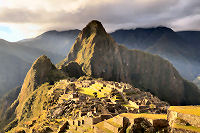 Last, but certainly not least, is Machu Picchu, one of the world's most famous historical sites. The atmospheric ruin of Machu Picchu is perched below the Andes and above the jungle.
Last, but certainly not least, is Machu Picchu, one of the world's most famous historical sites. The atmospheric ruin of Machu Picchu is perched below the Andes and above the jungle.
For the best experience, walk there on the Inca Trail or one of the alternative trails, which is certainly worth the exercise!
There are numerous companies offering a variety of tours, Inca Trail group hiking trips, multi-day Jungle Treks, and train tours.
The train to Machu Picchu on PeruRail departs from Poray (accessible by taxi or bus). The journey takes 4 hours.
Note that the railroad service between Ollantaytambo and Km. 82 may be disrupted or at times suspended due to landslides, mudslides and subsidence following sustained periods of very heavy rain, meaning that everybody must be transported to Km. 82 to get on a second train. An overland trip is a very good yet adventurous alternative way to get there.
More Cusco Airport Transfer & Airport Connection Options
- Cusco Airport Information
- Cusco Airport Distance to City Centre
- Cusco Airport Currency Exchange
- Cusco Airport ATM & Cash Machines
- Cusco Airport Wireless Internet Access
- Cusco Airport Maps
- Cusco Airport Flights, Arrivals, & Airlines
- Cusco Airport Taxi Service
- Cusco Airport Onsite Hotels
- Cusco Airport Private Transfer Services
- Cusco Airport Shared Shuttle Transfers
- Cusco Airport Location & Address
- Cusco Airport Train & Subway
- Cusco Airport Hotel Shuttle Transfers
- Cusco Airport Shuttle
- Cusco Airport Buses & Coaches
- Cusco Airport Limo & Private Car Transfers
- Cusco Airport Car Hire/Car Rental
- Cusco Airport Other Ground Transportation
- Cusco Airport Parking & Passenger Pickup
- Cusco Airport Stopover & Layovers
- Closest Airports to CUZ Cusco Airport
- Cusco Airport Services & Amenities


